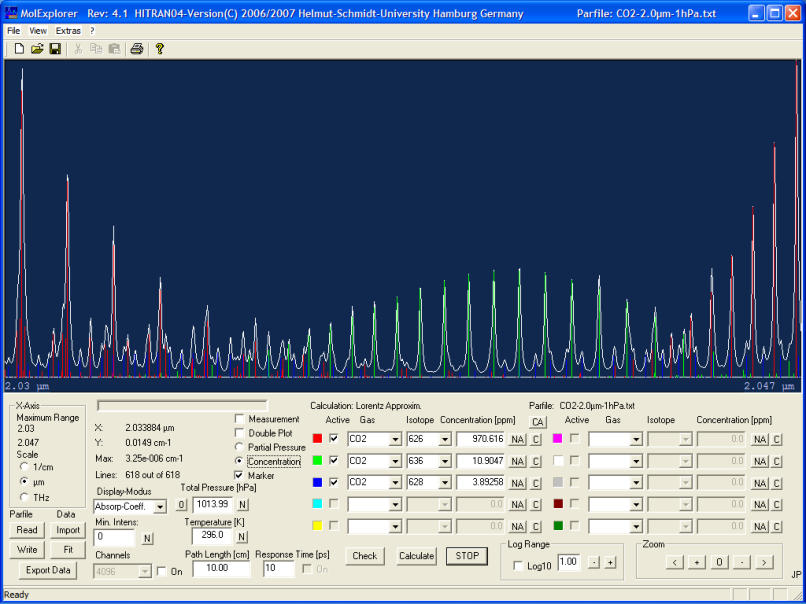
j) Spectral Calculation
It is an indispensable prerequisite for the • development of optical gas sensors, • the propagation of optical or infrared radiation through the atmosphere or • studies of TeraHertz femtosecond pulse propagation through dense gases to have detailed spectral information about the investigated molecules and also about possible candidates, which are overlapping in their spectra with the studied gas. Therefore, we developed a program for fast computation and display of molecular spectra on a PC Microsoft Windows® platform (Harde&Pfuhl [1]; Harde et al. [2]). This program, which we named MolExplorer, takes advantage of a database, in which the relevant parameters for the calculation of a spectrum are stored . The MolExplorer works with two different databases: • The HITRAN08 database contains the 39 most prominent molecules in the atmosphere and has stored 2.714 Mio spectral lines of these gases. 3 further gases (SF 6 , ClONO 2 and CF 4 ) with additional 2.981 Mio lines are found in a supplementary folder of the database. HITRAN is an acronym for High-Resolution Transmission Molecular Absorption Database and is a compi- lation of spectroscopic parameters to predict and simulate the transmission and emission of light in the atmosphere (Rothman et al. [3, 4]). • The GEISA-03-database (Gestion et Etude des Informations Spectroscopiques Atmosphé- riques: Management and Study of Atmospheric Spectroscopic Information) contains more than 1.6 Mio transitions of 42 molecules which are of interest for studies of the terrestrial as well as other planetary atmospheres (Jacquinet-Husson et. al. [5, 6]). The MolExplorer calculates the molecular absorption and models the attenuation of radiation in the atmosphere or under laboratory conditions. Within seconds it provides survey spectra from mm-waves up to the ultra violet as well as selected parts with highest spectral resolution, this for the most relevant gases and pollutants in the atmosphere (see: MolExplorer Manual, Harde [7] ). For this the user has to specify the molecules or isotopologues of interest, the spectral range and resolution, the respective partial pressures or concentrations, the buffer gas pressure (when re- quired), and perhaps additionally the temperature. The rest is accomplished by the MolExplorer. The lower screen shot shows the panel and graphical display of the MolExplorer, in this ex- ample for a spectral calculation around 2 µm for three CO 2 isotopologues, which can be distin- guished by colored markers.Some Additional Options
• Direct comparison of spectra from the HITRAN- or GEISA-database. • Import of measurements or other calculations and fit to these spectra with HITRAN- or GEISA-data. • Convolution of spectra with different instrument functions. • Propagation of radiation through the atmosphere under preselected elevation angles and over specified path lengths, accounting for changes in pressure and temperature broaden- ing of spectral lines and lineshapes with altitude above surface. • Consideration of Mie scattering and free-space-damping over the path length. • Radiation transfer calculations without or with cloud overcast in up- and down direction for three climate zones. References & Publications 1. H. Harde, J. Pfuhl MolExplorer: A Tool for Computation and Display of Molecular Spectra from the HITRAN and GEISA Database Helmut-Schmidt-University, 1995 - 2018 2. H. Harde, J. Pfuhl, M. Wolff, H. Groninga MolExplorer: A New Tool for Computation and Display of Spectra from the HITRAN Database, Session 5 (Database), 9th HITRAN Database Conference, Harvard-Smithsonian Center for Astrophysics, Cambridge, MA, USA, 25.-28. June 2006 http://cfa-www.harvard.edu/hitran/HITRAN_conf06_presentations/Session5/5.5-Harde.pdf 3. L. S. Rothman et.al., “The HITRAN Molecular Spectroscopic Database and HAWKS; 1996 Edition”, J. Quant. Spectrosc. Radiat. Transfer 60, 665–710 (1998) 4. L. S. Rothman et.al., “The HITRAN 2008 molecular spectroscopic database”, J. Quant. Spectrosc. Radiat. Transfer 110, 533–572 (2009), http://www.hitran.com or http://www.cfa.Harvard.edu 5. N. Jacquinet-Husson et. al., “The 2003 edition of the GEISA/IASI spectroscopic database“, J. Quant. Spectrosc. Radiat. Transfer 95, 429-467 (2005) 6. http://ara.lmd.polytechnique.fr/htdocs-public/products/GEISA/HTML-GEISA/IasiDatabase_pres.pdf: “The 2003 Edition of GEISA: A Spectroscopic Database System for the Second Generation Vertical Sounders Radiance Simulation” 7. H. Harde, Manual of MolExplorer, Helmut-Schmidt-University, 2012



Physics & Climate















